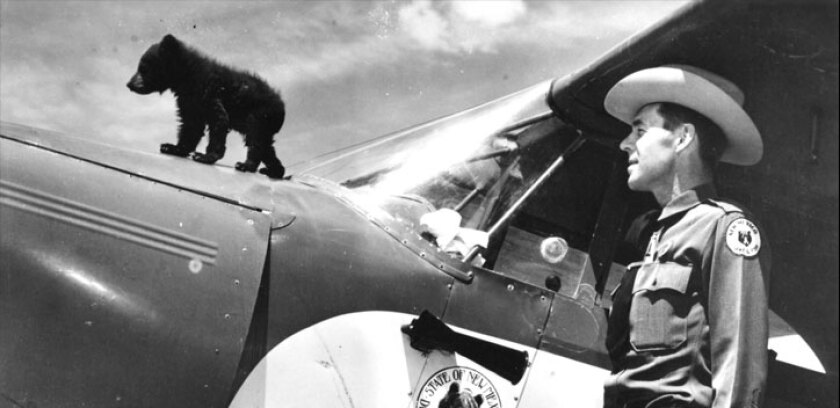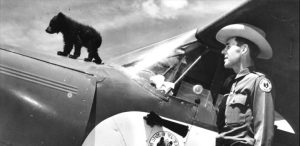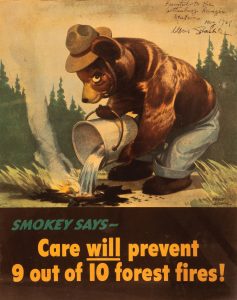
Many people of a certain age have a special affection for Smokey Bear (or Smokey the Bear, as he has also been called).

I remember reading Smokey’s story—how he was rescued from a wildfire in New Mexico in 1950 and became the symbol of fire awareness in the woods for generations. Posters and signs showing Smokey in a park ranger hat were ubiquitous in those first years after the bear’s appearance on the national stage.
As a kid riding in our family’s old Chevrolet into Great Smoky Mountains National Park, I made an immediate connection between Smokey and the Smokies and assumed that the names somehow were related. I admit, however, that I was confused about the two spellings: “Smokey” for the bear and “Smoky” for the park. I couldn’t reconcile that disparity in my young brain, and I’m sure the two spellings still confuse some folks.
Smokey’s story is one of survival against the odds. As fire swept through the Capitan Mountains in New Mexico, the black bear cub—apparently orphaned by the blaze—was trapped. He climbed into a tree to escape the flames but nevertheless had badly burned paws and legs when a firefighting crew rescued him.
After the cub was treated for his burns in Santa Fe and news of his harrowing experience continued to spread, he was made into a popular icon for fire prevention by the US Forest Service and eventually relocated to the National Zoo in Washington, DC. He lived at the zoo until his death in 1976 and was buried at Smokey Bear Historical Park in New Mexico. Often depicted with a firefighting shovel, Smokey remains a striking symbol for conservation and responsible stewardship across numerous landscapes—even if the nuances of his fire-prevention message have evolved over the years.

Today, SmokeyBear.com continues to share information about campfire safety, but the website also features educational resources about fire science and the ecological benefits of fire for different ecosystems. Keeping pace with more contemporary understandings of fire ecology, Smokey’s likeness helps to educate young people about the oak-hickory forests and Southern pine communities that rely on periodic fire disturbance to remove shade, reduce leaf litter on the forest floor, and disperse the seeds of trees with serotinous cones, like the Table Mountain pine found in the Great Smoky Mountains. Smokey still sticks by his old catchphrase—“Only you can prevent wildfires”—but his message also acknowledges the importance of controlled burning and the long history of Native Americans using fire to reshape and rejuvenate the landscape.
Still, with the arrival of autumn, the specter of wildfires is quite real in the Smokies, particularly during dry periods after millions of leaves have fallen. And memories of the destruction that fires can bring are still fresh.
The dangers associated with out-of-control fires were illustrated in full in the fall of 2016 when a human-set fire was reported near Chimney Tops. Crews tried to put the fire out, but strong winds spread the blaze into other areas of the park, eventually burning across about 11,000 acres.
Remarkably, the fire did not damage any buildings in the park, although it reached the lower slopes of Mount Le Conte. The historic LeConte Lodge was not damaged, a fact the lodge’s long-time manager, Tim Line, didn’t know until a small plane flew over the site to check on possible damage.
“Our happiness at saving the lodge was muted by the unbelievable human impacts,” he said. “It was the saddest event that I ever experienced in a lifetime in the Smokies.”
Fourteen lives were lost, and hundreds of homes, businesses, and other buildings were destroyed from the complex of wind-driven wildfires that were ignited from downed powerlines outside the park and the arson-caused Chimney Tops 2 fire.
As wildfires rage across areas of the West and become increasingly common thanks in part to the effects of climate change, it’s more important than ever to be cautious around fire and pay attention to our old pal Smokey. In the United States, nearly nine out of ten unplanned wildfires are still caused by humans.
At SmokeyBear.com, you can take the Smokey pledge:
• be careful anytime you use fire or items that can cause sparks.
• never leave your fire unattended.
• drown, stir, drown again, and feel it’s cool with the back of your hand when you put out your fire.
• do NOT use fire or operate equipment when it’s windy, dry, or hot.
• make sure there are at least 15 feet between your fire and flammable things.
• always have a water source nearby.
• put out and discard smoking materials properly.
• do NOT dump hot ashes from your BBQ grill or firepit.
Subscribe to get the latest posts sent to your email.
The Great Smokies Welcome Center is located on U.S. 321 in Townsend, TN, 2 miles from the west entrance to Great Smoky Mountains National Park. Visitors can get information about things to see and do in and around the national park and shop from a wide selection of books, gifts, and other Smokies merchandise. Daily, weekly, and annual parking tags for the national park are also available.